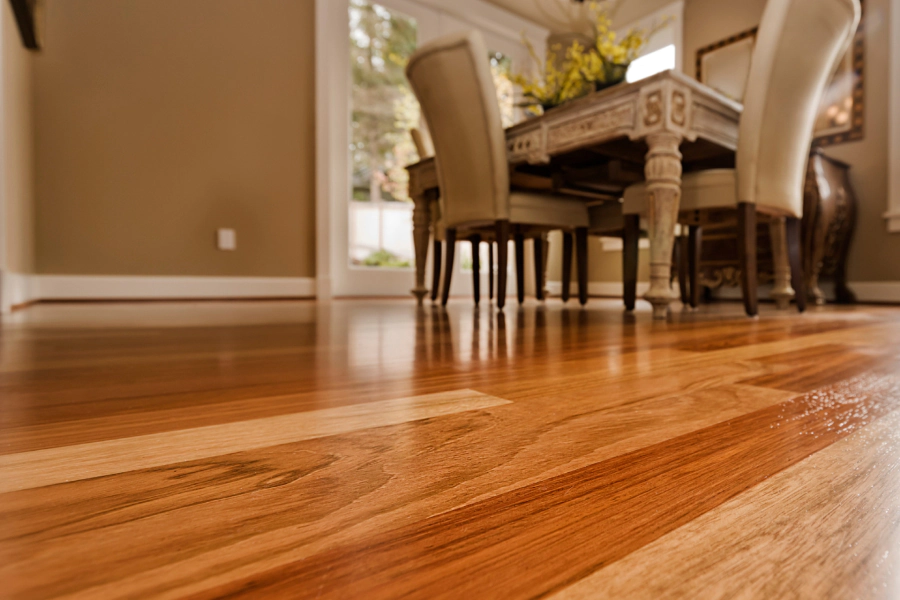
Solid Wood
Solid wood boards are those made from a single source of material, such as a single tree or type of wood, rather than a combination of natural and synthetic (or all synthetic) products. Generally, solid wood refers to individual boards — it’s unlikely you’ll make an entire floor from a tiny trunk — but can more broadly describe all naturally sourced, non-synthetic wood products.
Joists
In most buildings, especially homes, you’ll find beams called “joists” that support various structures and levels of the construction, but usually it’s just to keep the ceiling from crashing down onto the floor beneath it. So why do joists matter if we’re talking about hardwood? Well, the angle and installation style of the joists in your home will determine the plane and layout of your future floors. To create maximum support and stability, you’ll want your hardwood floors laid perpendicular to any joist beams.
Underlayment
If you’re at all familiar with roofing terminology, you’ve most likely heard the term “underlayment.” But did you know it’s also used in the flooring industry? Very similar to its roofing counterpart, the underlayment of a hardwood floor is the intermediary layer between the top-level durable wood and the lower level subfloor. Underlayment can serve a number of purposes for hardwood floors, but most commonly, it will be used as insulation, to shield against moisture and vapor, to minimize the echo of loud noises, and to serve as structural padding. The materials used to make underlayment for hardwood floors vary, ranging from foam to cork to plastic synthetics.
Base Shoe
Any time our New Jersey flooring company installs a new unit of hardwood, it pays careful attention to the dimensions of the base shoe. This refers to the small gap between the walls and the hardwood designed to accommodate natural expansion and contraction of the wood throughout temperature fluctuations. The base shoe, also known as a shoe molding, is applied to the lower part of the baseboard, meeting the space between the floor and the wooden wall trim.
Beveled Edge
In the world of hardwood flooring, “edge” normally refers to the end of each individual board of wood. Traditionally, you might associate the edges of these planks with a true right angle. A beveled edge, by contrast, is a halved 90-degree angle featuring gentle 45-degree tips. This modification to dimensions allows the planks to be fitted together more easily and compactly.
Pinworm Hole
Have you ever been exploring a forest and noticed a piece of wood with small holes and wormlike tracings on it? That’s from small insects and other critters munching — boring — through the wood. This happens often in nature, but you don’t want it to happen to the planks used to assemble your own hardwood floors. To prevent pinworm holes in your home’s hardwood, you’ll want to work with a trustworthy flooring company that certifies and inspects all of its products, like All Flortec does.
Janka Scale
Similar to the Mohs hardness scale, the Janka Scale is used to rank different kinds of wood by their respective responses to applied force. In the Janka scale, the force is applied using a small steel ball against a dimension-specific sampling of the tested wood. The higher the number of Janka units, the more force (and scratches and wear and tear) the wood can take. Depending on the needs of you and your household, you may opt for a softer or a more durable hardwood.
Crowning
It may sound like a term pertaining to royalty or kings, but crowning is not something you want to see happen to your hardwood. When moisture or humidity make their way into the subfloor or underlayment, the buildup of damp air and water can cause the boards of your floor to swell and distort upward in shape. This is “crowning.” It can usually only be fixed with professional floor sanders or, if the damage is extensive enough, full replacement of the boards.
CONCLUSION
This concludes our first installment on hardwood flooring terms, but we will be publishing more content of a similar kind in the future. You can never know too much when it comes to home improvement, so there’s plenty to discuss beyond this brief article.
For more information about hardwood flooring, technical industry terms, and how a repair or renovation can enhance the aesthetic appeal and functionality of your home, please reach out to All Flortec today!